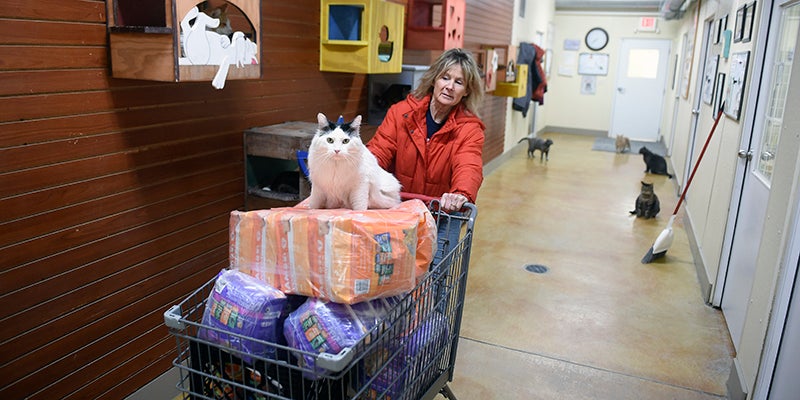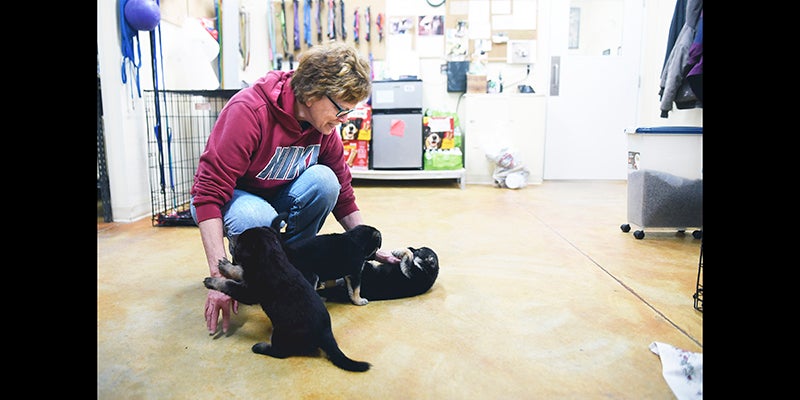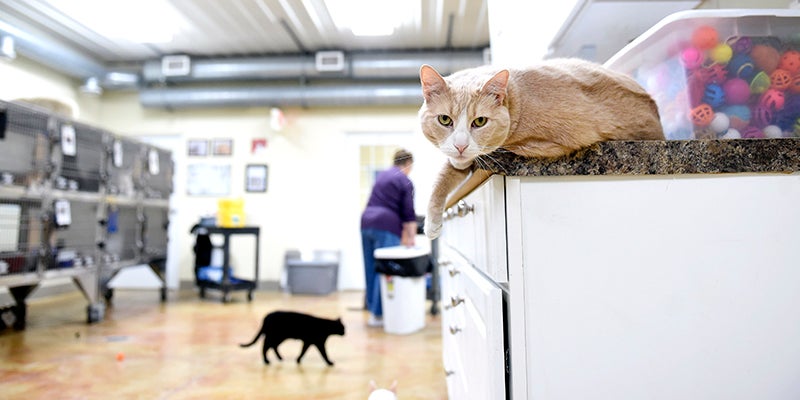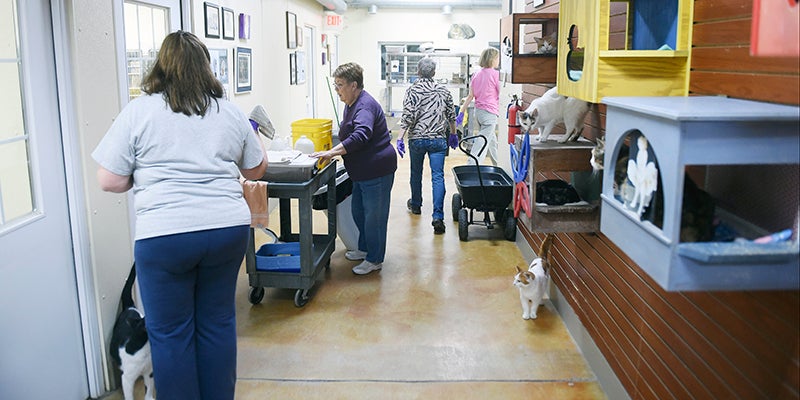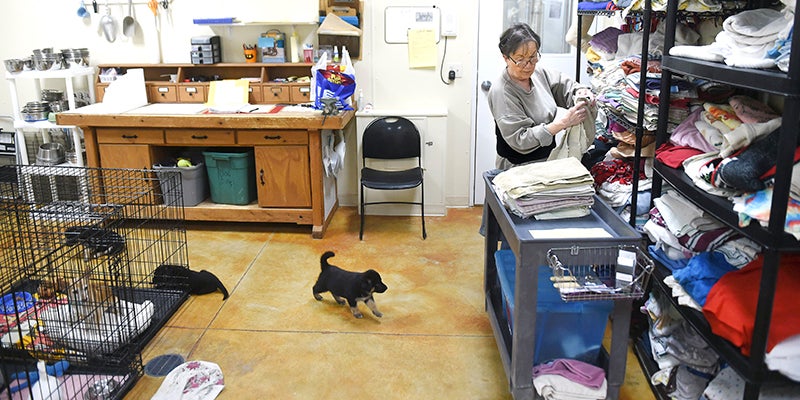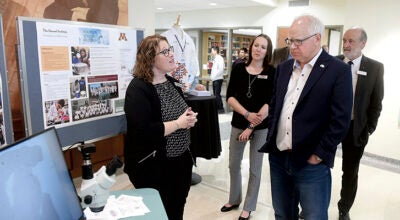Austin Living: For the Animals
Published 6:15 pm Tuesday, March 14, 2023
|
Getting your Trinity Audio player ready...
|
Volunteers play central role in finding the Mower County Humane Society’s residents a home
It’s early in the evening on a January night and Mower County Humane Society volunteer Rhonda Benson disappears into a back room hoping for the best.
It’s followed moments later by the words, “Well that didn’t work,” followed by a herd of puppies loping awkwardly into the room, filling it immediately with a puppy’s energy. Mom, a well-mannered, friendly dog, follows wearily behind just looking for a bit of respite.
The chaos is repeated days later during a noon feeding by dog side manager Carey Sharp.
“We’re kind of a crazy group,” Sharp said. “We have to be to put up with the dogs on a daily basis.”
Indeed, on the first night the dogs in the many kennels filling the south side of the building echoes with barking and howling, creating a din that volunteers cope with every day throughout the year.
On the cat side, things are a little bit more subdued. With over 130 felines, though, it’s wise to pay heed to where one’s stepping. There are cats everywhere, walking along the floor, watching the evening feeding and cleaning from their cages and in special cat boxes attached to the walls.
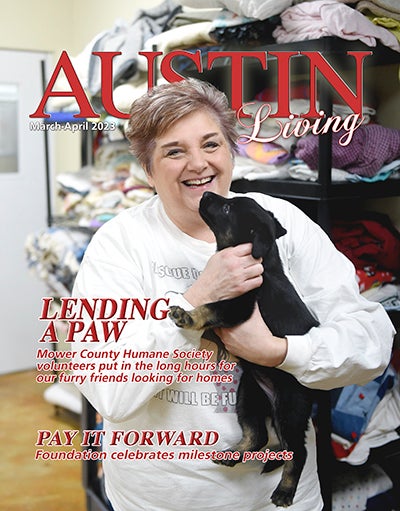
Find the rest of this story and more in the latest edition of Austin Living Magazine — out now!
One of the cats even gets a ride on a cart filled with freshly donated food being wheeled through the throng by volunteer Lisa White.
“I don’t think people realize how many pets we do process here,” said cat side manager Kelly Rush.
It’s probably something that is lost on many in the community outside of the Humane Society itself. For many, they are simply coming to the Humane Society to adopt their next family member.
The hustle and bustle of the inner workings is largely unseen and so the idea that the entire Humane Society is volunteer run sometimes falls by the wayside.
But that’s exactly how it has been run. There is not one person at the Humane Society that is paid, even though there are some, including both managers, that work the equivalent of part time jobs.
It’s not easy work either.
“It’s physical. It’s very physical,” Rush said. “You do a lot of bending. Bending over and lifting, moving fast sometimes to interrupt something.”
Dog side volunteers usually get the shelter started at around 5:30 a.m. every morning followed not long after by cat side volunteers. Both sides are there for a few hours before they are able to leave.
It’s time consuming and made even more challenging because of the lack of volunteers. Each side has a core number of volunteers, but even with a full complement of volunteers scheduled, the work is such that more volunteers are always appreciated.
“That’s why it’s so important that if somebody does take on the commitment and say they want to volunteer and sign up — it’s so important that they come,” Sharp said. “You look at the schedule and see it’s four people and only two show up, that’s a big, big difference.”
That’s especially true when you consider how quickly animals come to the shelter. The cat side is consistently pushing the upper limits of capacity if not going over most of the time.
Dogs seem to get a new animal every time a dog is adopted out.
“As soon as one is adopted on either side, we have another one coming in,” Rush said. Often, these animals are coming from the City Pound. “When one is adopted, I have a choice of about 20 that want to come in.”
While the need for volunteers is near constant, the Humane Society does need to be cautious about who it accepts for volunteers.
Many families will see it as an opportunity for their kids to volunteer and while families as a whole will volunteer from time to time, but it’s hard to have kids on their own doing the work.
Not only because the physical work is demanding, but because a person needs to be able to read a situation. There is so much volunteers need to be aware of.
“You have to be careful,” Sharp said. “You can’t put this dog next to that dog. That dog, you should put out last so you don’t walk it past other dogs. You have to be aware of their personalities and their quirks and what they are capable of doing.”
The same is true on the cat side where volunteers need to be able to react quickly as well as be able to identify health issues.
“We’re kind of an extension of vet clinics,” Rush said. “I kind of think of it that way, which I never knew when I started volunteering here. When you’re cleaning a box you’re looking for stuff in that box. Do they have worms, parasites? You also have to read body language on both of them.”
However, the mission of the Humane Society is passionately carried out by each volunteer who does what they do for the animals. To make sure they are cared for and they are going to a home where that care will continue.
Adoptions are carefully vetted, making sure that they are going to a good home and that the people doing the adopting are capable of taking care of the pet.
To that end, a major component of what volunteers do is educate, ensuring people know what they are getting into when adopting a pet.
“I would like to think that we try to educate people as much as we can,” Sharp said. “One of my biggest concerns is trying to get people to understand that when you are taking on a dog especially, you can’t think in terms of a couple months. You have to be thinking about years and years.”
There’s also a control aspect.
“I think we do a pretty big service to this community,” Rush said. “What we do is we help control unwanted.”


